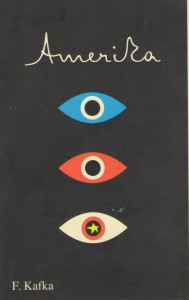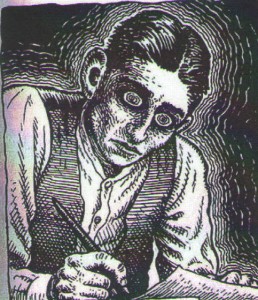Watch movie based on this book:Klassenverhaltnisse (Class Relations, Jean-Marie Straub & Daniele Huillet,Part 1/12)
 This is an important examination of immigrant life in America made by Franz Kafaka although he himself never visited America in his life.
This is an important examination of immigrant life in America made by Franz Kafaka although he himself never visited America in his life.
The story he put in writing was about the young Karl Rossman who, after an incident involving a housemaid, is banished by his parents to America. Expected to redeem himself in this magical land of opportunities, young Karl is swept up instead in a whirlwind of dizzying reversals, strange escapades, and picaresque adventures.
himself in this magical land of opportunities, young Karl is swept up instead in a whirlwind of dizzying reversals, strange escapades, and picaresque adventures.
Kafka began writing this book under the title “Der Verscholbene” (“The Missing Person”) in 1912 and completed in 1914. But it wasn’t until 1927, three years after his death that Max Brod edited unfinished manuscript and published it as “Amerika”.
The movie based on this novel, is called “Class Relationship”. Why? To understand this, let’s go to page 58 and read:
“Whereas Mr. Pollunder kept a friendly eye on karl as he headed toward the door, Green did not even turn to look at Karl-even though one does instinctively tend to to meet the eyes of the person opposite-and Karl thought that his behavor reflected Green’s belief that each of them should try to get by on the strength of his own abilities-Karl for himself, Green for himself-and that it would the victory or annihilation of one or the other before the inevitable s o c i a l relationship could be established.”
That’s how Kafka attracts readers’ attention.
We probably don’t need to be told that purposefully ignoring someone requires fighting off natural visual impulses in order to recognize rude behavior-that’s just Kafka twisting the knife in the worldview of his protagonist and narrator. This display of disrespect allows Karl to extrapolate, or exaggerate, an understanding of the world in which  social relationships require victory or annihilation. How a relationship that presupposes annihilation is even possible, to say nothing of inevitable, is less a question than a feature of the world that Kafka’s figures inhabit. One of the features of the world we inhabit when we read Kafka is an encounter with contradictions that, rather than impeding the flow of the story, sometimes, surprisingly, propel it forward.
social relationships require victory or annihilation. How a relationship that presupposes annihilation is even possible, to say nothing of inevitable, is less a question than a feature of the world that Kafka’s figures inhabit. One of the features of the world we inhabit when we read Kafka is an encounter with contradictions that, rather than impeding the flow of the story, sometimes, surprisingly, propel it forward.
I feel this Kafka’s Amerika is closer to the truth of Kafka’s writing.
The photos of the front cover of the book and other interesting photos are shown here and there.
Мир Кафки и мир, где мы живем – две большие разницы? Мне представляется не такой уж большой.
На работе пришлось столкнуться с уничижительным отношением к иммигрантам со стороны коллег. В общем без такого унижения не проходило дня.
К большому сожалению, это правда. Как бы хотелось, чтобы люди были лучше, стремились понимать друг друга, принимали их как есть, стараясь не переделывать друг друга, а жить в мире и ладу каждый момент жизни, который предоставлен нам свыше.
Валентина